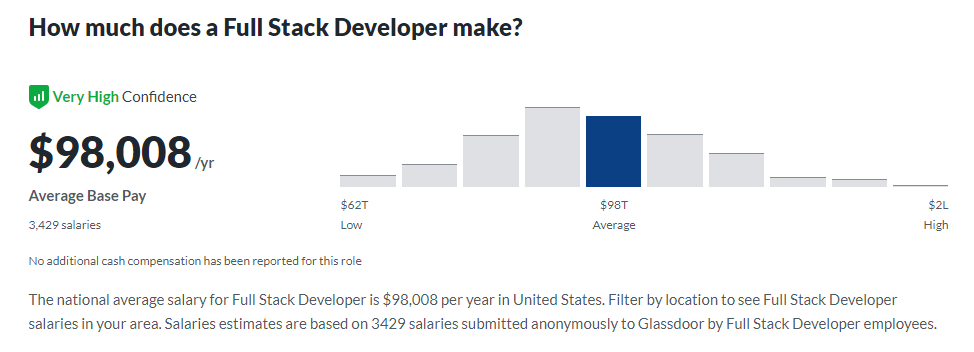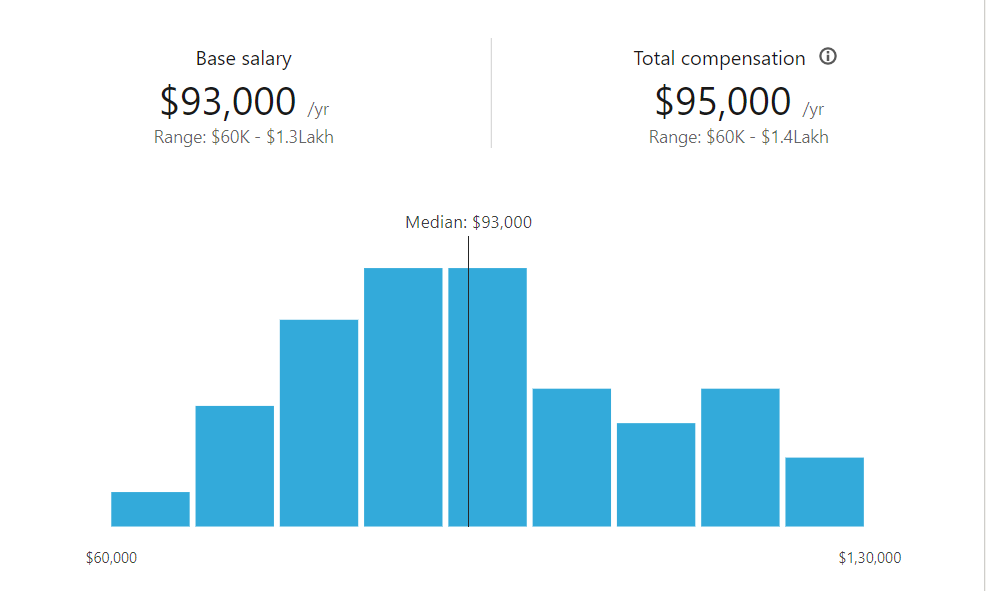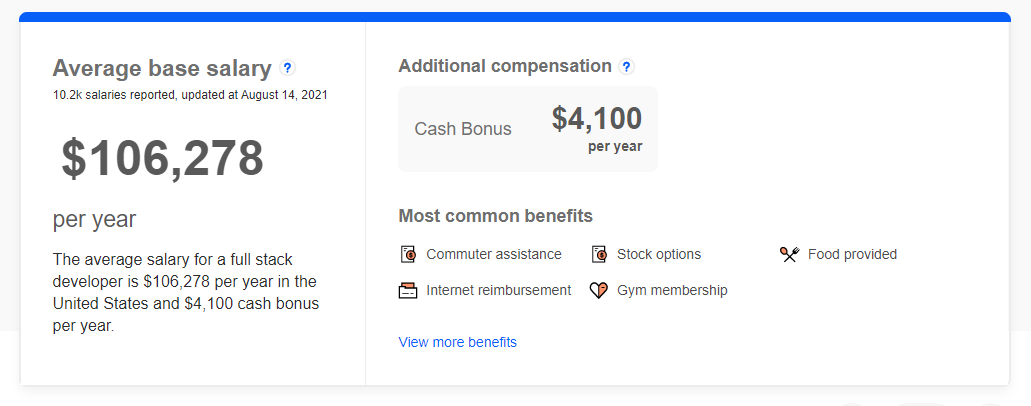How to Become a Full Stack Developer(A Step By Step Guide)
How to Become a Full Stack Developer (Step-by-Step Guide)
No one could fault you for feeling a bit overwhelmed.
After all, a quick Google search for “full stack development” renders an impossibly long list of acronyms: HTML, CSS, JS, MySQL, and PHP, just to name a few. At heart, full stack developers are highly versatile jacks-of-all-trades in an industry that demands comprehensive programming knowledge.
Take a breath: learning how to become a full stack web developer isn’t as difficult or time-consuming as you initially might think. In this article, we’ll walk you through the basics of full stack development, what you need to learn, and how you can prepare yourself for a full-blown career in development.
Wondering what’s next? Here’s a sneak peek at our six steps to becoming a full stack developer:
- Identify The Skills You Need to Learn
- Determine Your Ideal Timeline
- Start Learning in a Format That Suits You
- Begin Building Your Portfolio
- Start the Job Search
- Ace the Interview
What is a Full Stack Developer?
To become a full stack developer, you’ll need to familiarize yourself with two basic web development concepts: the front end and the back end.
The front end, also known as client-side or customer-facing side, refers to all the elements of a computer application that users interact with directly. By contrast, the back end encompasses all the behind-the-scenes tech that computes business logic, fulfills user requests, and permanently stores sensitive data.
You can think of the front end as the tip of an iceberg, while the bulk of the unseen back end extends far below the water’s surface.
Front end developers create and optimize visible parts of a website, making components responsive to different viewing environments, such as smartphones, tablets, and desktops. They use client-facing programming languages, like HTML, CSS, and JavaScript, to render an engaging site.
On the other hand, back end development requires programmers to build and refine the internal software that operates a company’s databases, servers, and proprietary software. Back end developers are responsible for creating the pathways to deliver information to and from users who operate front end interfaces.
This is where full stack development comes in. “Full stack” refers to the entirety of a site or application’s front and back end architecture. As you might expect, full stack professionals are capable of addressing both sides of the proverbial equation.
Identify the Skills You Need to Learn
Every learner’s path will be slightly different depending on their preexisting experience and skill set. If you’re a true beginner, you’ll require specialized training and project experience to become a developer. The same applies to hobbyists, who will need to upskill much more than professional developers who hope to upgrade their careers.
Take stock of your skills! Here are a few basic capabilities that you’ll need to master if you want to thrive as a full stack developer:
- HTML
- CSS
- JavaScript
- DOM Manipulation
- SQL/NoSQL
- Java
- Object-Oriented Programming
While a full stack developer’s education is never really complete, the above skills will provide you with a sturdy foundation!
| Skills | Language | Type | Active Developers | Famous Web App | Download |
|---|---|---|---|---|---|
| Front End Development | HTML | Markup Language | 1.3 million | Netflix | HTML |
| CSS | Style Sheet Language | – | Gmail | CSS | |
| JavaScript | Object Oriented Language | 12.4 million | JavaScript | ||
| Back End Development | PHP | Scripting Language | 5 million | WordPress | PHP |
| Python | Scripting Languagee | 7 million | Python | ||
| Ruby | Scripting Language | 1.5 million | GitHub | Ruby | |
| Java | Object Oriented Language | 8.2 million | Java |
Determine Your Ideal Timeline
How soon do you want to go from hitting the books to landing your first entry-level developer position? As with your earlier skill assessment, establishing a concrete timeline can help you choose your educational journey.
Consider the following questions:
- Are you willing to take part-time courses while maintaining your current job?
- Would you prefer an intensive, full-time education that would allow you to land a job as quickly as possible?
- Do you prefer quicker, skills-based courses or formal, theory-heavy education?
- What learning opportunity will allow you to pursue your education without infringing on your personal obligations?
If you’ve already locked yourself into a full-time career or family commitments, it can be challenging to start a new training regimen. But it is by no means impossible. Think about the changes you’re willing to make to pursue your dreams — and build your educational schedule accordingly.
Start Learning in a Format That Suits You
In the era of open-source everything, it’s easier than ever to learn how to become a full stack developer — but it’s also easier to get lost in the muck. There’s a near-daunting number of distinct educational routes available to newcomers.
Below, we touch on the primary methods that aspiring developers use to become marketable programmers, and provide resources to help you on your journey.
There isn’t one best way to learn full stack development, so while you’re perusing the options, make sure to compare your timeline and learning requirements to the listed opportunities.
Boot Camps
Coding boot camps are short-term, highly intensive training courses that equip you with all the industry-ready skills you need to become a fully fledged developer. By the time you complete a boot camp, you’ll have gained the necessary skills, made vital industry connections, developed an impressive coding portfolio, and prepared yourself for the job hunt.
Unlike conventional four-year degree tracks, boot camps provide a quick way for hobbyists and total newcomers to learn the necessary skills. Most of these intensive courses complete within three to six months and are cheaper than a university education. Boot camps also offer more flexibility than pursuing a formal degree; many offer part-time, full-time, virtual, and in-person training options.
If you’re curious, make sure to check out Columbia Engineering Coding Boot Camp, which dives into all the most in-demand front and back end technologies, including HTML, CSS, JavaScript, MySQL, MongoDB, React, and Java.
Self-Guided Courses
Are highly structured training courses not your cup of tea? Thankfully, there’s an enormous selection of instructor-guided, self-led virtual courses readily available for new learners.
Compared to boot camps, self-guided courses offer much greater flexibility and a lower cost — some are even free! Depending on the platform you opt for, you may even have access to additional resources, instructor support, and an active learner community.
That said, self-guided courses differ significantly in terms of quality. While some may provide extra resources, many don’t. The amount of support you receive is, in most cases, tied to the money you shell out — although that logic shouldn’t preclude you from thoroughly vetting platforms before you enroll! Check out participant reviews and only take courses that have been published through reputable platforms.
Additional Resources
Below, we’ve listed a few of the most-loved coding course platforms. Each of the linked sites provides easy-to-follow and relatively inexpensive front end, back end, and full stack development tutorials.
- Coursera: Coursera offers an enormous menu of full stack web development courses ranked by learner star ratings. Many courses focus on specialties such as multi-platform app development, responsive website design, Android/iOS development, and object-oriented programming.
- Udemy: Nearly 300,000 registered learners are currently learning full stack development on Udemy. Considered one of the most trusted self-led platforms, Udemy offers both technology-specific courses and theoretical materials for those that want a deeper dive.
- FreeCodeCamp: Want to avoid paying tuition for the fundamentals? FreeCodeCamp provides an easy way to build projects, earn certifications, and learn to code from home. The site covers topics ranging from data visualization to web design, data structures, and coding interview prep.
Books and Tutorials
- The Full Stack Developer by Chris Northwood. In this pivotal book, Northwood explores the essential skills every full stack developer needs. The book is primarily geared towards developers new to AGILE development, project management, QA, and back end patterns.
- Eloquent JavaScript by Marjin Haverbeke. Haverbeke balances the nitty-gritty technical aspects of the language JavaScript with a principled approach. The book is tutorial-style, allowing developers to follow along with their own projects.
- ASP.NET Core 3 and Angular 9 by Valerio De Sanctis. De Sanctis explores the latest developments in designing, building, and deploying a Single Page Application with ASP.NET and Angular. Full stack at heart, the book touches on data management, web APIs, app design, and deployment.
- Full-Stack React Projects by Shama Hoque. Curious about the MERN stack? Hoque uncovers how to create dynamic web applications and leverage the power of React.js to build complex interfaces.
Begin Building Your Portfolio
What Does Full Stack Developer Do?
Roles Responsibilities Front end developments Structuring about the front end website architecture Back end development In back end development, functionality, servers, and databases are created Optimization Assuring mobile phone cross-platform optimization. Responsiveness in all platforms Assuring application responsiveness Designing Working on-site design elements with graphic designers Finalizing the project Turning an idea into a reality by completing the entire project Expectations Assembling technical and consumer needs API Designing and developing APIs
| Roles | Responsibilities |
|---|---|
| Front end developments | Structuring about the front end website architecture |
| Back end development | In back end development, functionality, servers, and databases are created |
| Optimization | Assuring mobile phone cross-platform optimization. |
| Responsiveness in all platforms | Assuring application responsiveness |
| Designing | Working on-site design elements with graphic designers |
| Finalizing the project | Turning an idea into a reality by completing the entire project |
| Expectations | Assembling technical and consumer needs |
| API | Designing and developing APIs |
Now let’s discuss the average full stack developer’s salary in the USA based on some prominent job portals.
Start the Job Search
Glassdoor

Image Source: Glassdoor
Average Base Pay: $98,703
Reported Salaries: 3326







Comments